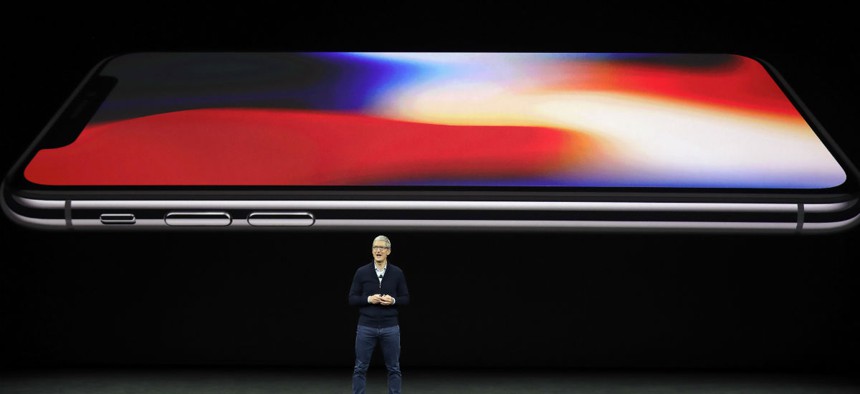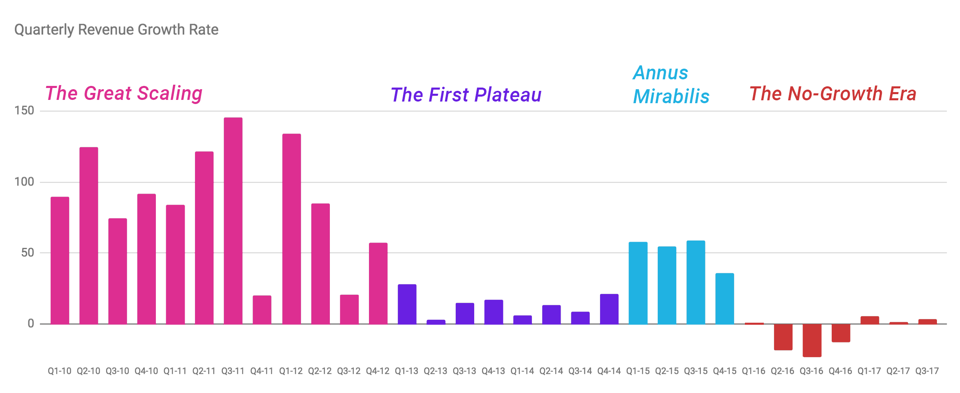Why the New iPhone Is So Important

Apple CEO Tim Cook announces the new iPhone X at the Steve Jobs Theater on the new Apple campus, Tuesday, Sept. 12, 2017. Marcio Jose Sanchez/AP
As Apple unveils the latest version of the most successful consumer product of all time, two charts show the critical juncture the company faces.
The iPhone is the single most successful consumer product of all time. It’s generated $762 billion of revenue for Apple, the most valuable company listed on the American stock exchanges. It has made Apple, more or less, the iPhone company.
And the model that the iPhone established—phone-on-glass, apps-on-phone—is “eating the world.” All of which which makes Tuesday’s upcoming announcement of the next generation of the phone an important event for the technology industry, generally.
But it’s an even bigger deal for Apple at this particular moment. Looking back at all the quarters since the company launched the iPhone in the fall of 2007, it is clear that this set of phones, this announcement, will determine if Apple can return to major unit and revenue growth or if Apple’s tremendous run building an already huge and profitable user base is over.
With the benefit of hindsight, it’s possible to discern several clear quantitative periods for the iPhone business. Here they are in a chart of the number of iPhone units sold each quarter since launch (note that Apple, like many companies, begins its fiscal year in October, so the extremely important holiday season falls into Q1):

First, there was the launch phase, in which Apple was selling just single-digit millions of phones, but its growth rates were phenomenal. Let’s call this The Launch Hyper Growth phase. It lasted from the third quarter of 2007 until the first quarter of 2010. Comparing quarters with the year prior (e.g. Q3 2009 vs. Q3 2008), the company posted annual growth of between 470 percent and 8,280 percent, despite supply problems.
Then, for three full years, Apple entered the The Great Scaling epoch. During this time, some notable things happened; Steve Jobs died in what Apple would call the first quarter of 2012. But nothing stopped the upward movement of the iPhone. Apple went from selling 8 to 9 million phones each quarter to selling between 26 and 37 million phones. The average year-on-year revenue growth through this period was 87.3 percent.
Next was the blowout first quarter of fiscal year 2013. Apple sold 47.79 million iPhones. And for two years, the company struggled to show the kind of growth in revenue or unit sales that it had in the previous three years. They were getting huge, and it made sense to many industry analysts that the “law of large numbers” would drop their growth rates considerably. It was The First Plateau. For these two years, Apple’s iPhone revenue averaged a year-on-year increase of a much more modest 14.1 percent.
Then came 2015. The Annus Mirabilis, or miraculous year. It started with selling nearly 75 million units in the first quarter and continued with huge unit and revenue leaps over the previous year. After many quarters of slowing growth, Apple blew the doors out with its new large-screen phones and they almost quadrupled their average year-on-year quarterly revenue growth to 51.7 percent.
In context, it has to be seen as one of the greatest corporate performances the world has ever seen. It was truly shocking.
Now, there’s the fiscal year 2016 and 2017 so far. Having posted such enormous numbers in The Annus Mirabilis, Apple has found itself unable to show growth without some exciting new species of phone. In the second quarter of 2016, revenue and unit sales fell on a year-over-year basis for the first time. Across the board, the average unit and revenue growth fell by 4.4 percent and 6.2 percent, respectively.
If you’re looking at the chart above and wondering how anyone could be worried about Apple, take a look at the chart below showing revenue growth rate.

Now the question is: As we roll the clock forward, will The No-Growth Era become simply The Second Plateau, or has Apple reached the edge of what’s possible for its high-price, high-margin mobile phone?
It’s all riding on this next generation of iPhones. Which could make Tuesday’s keynote/marketing speech a much more interesting affair than the last several Apple events.
NEXT STORY: CenturyLink delays Level 3 acquisition






